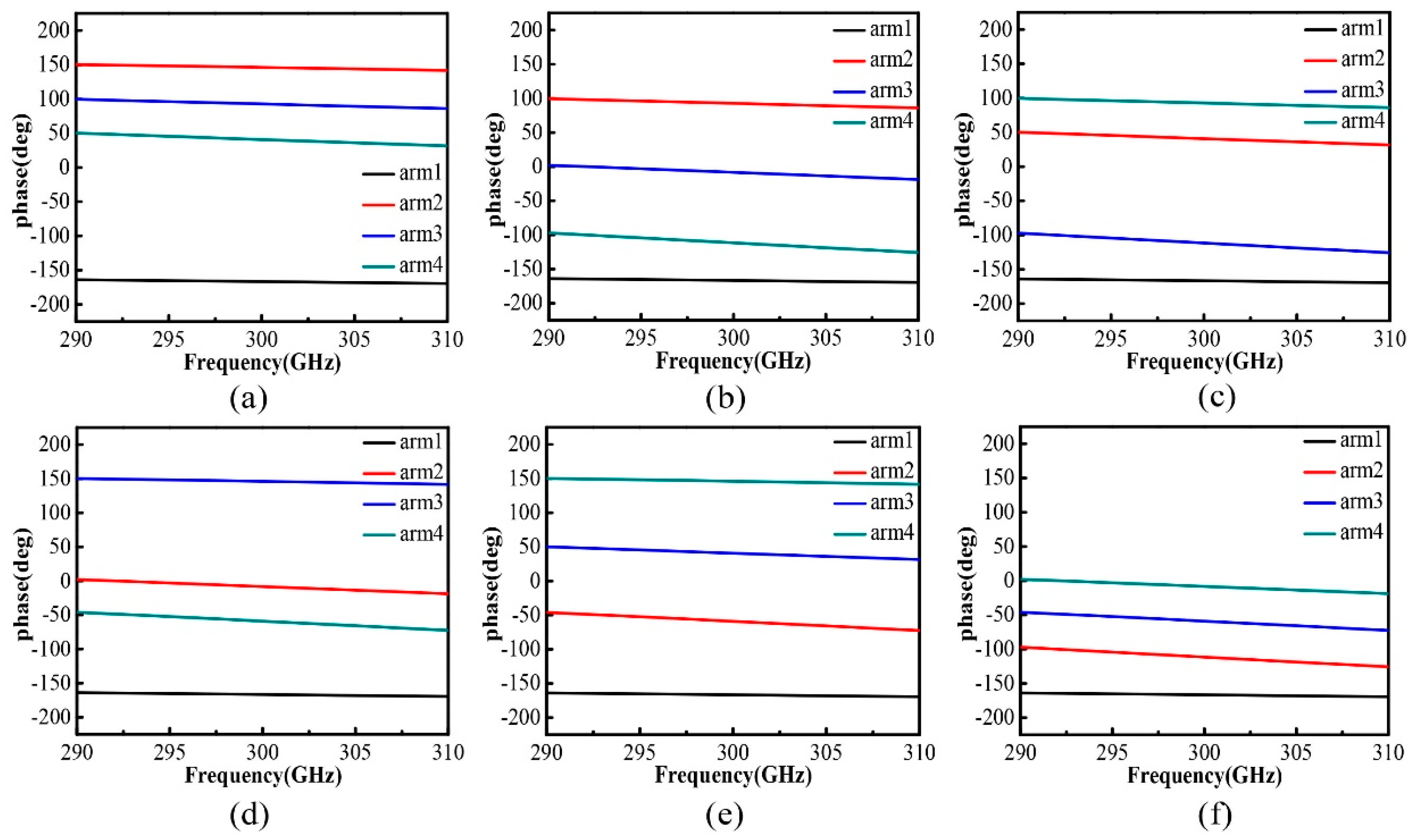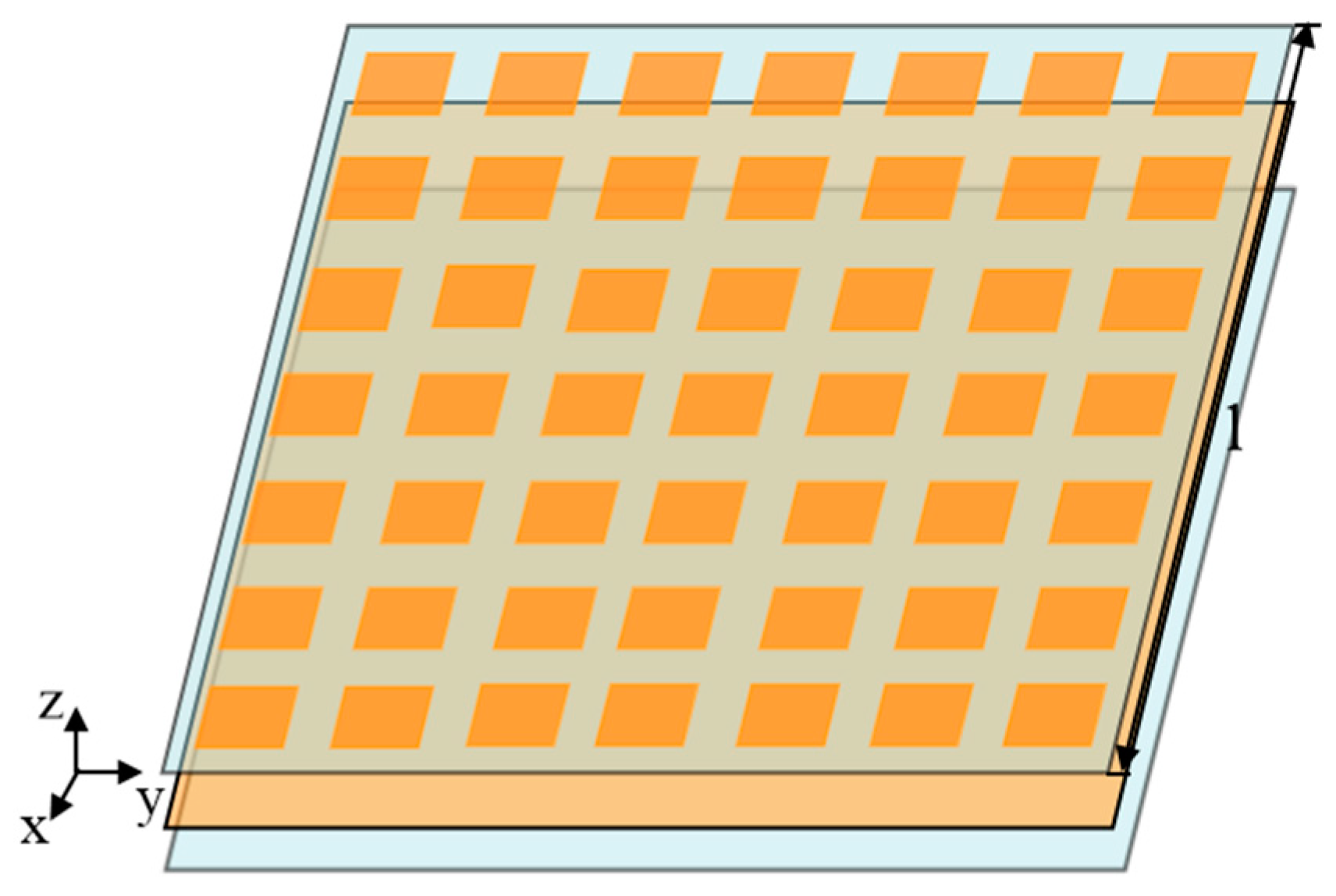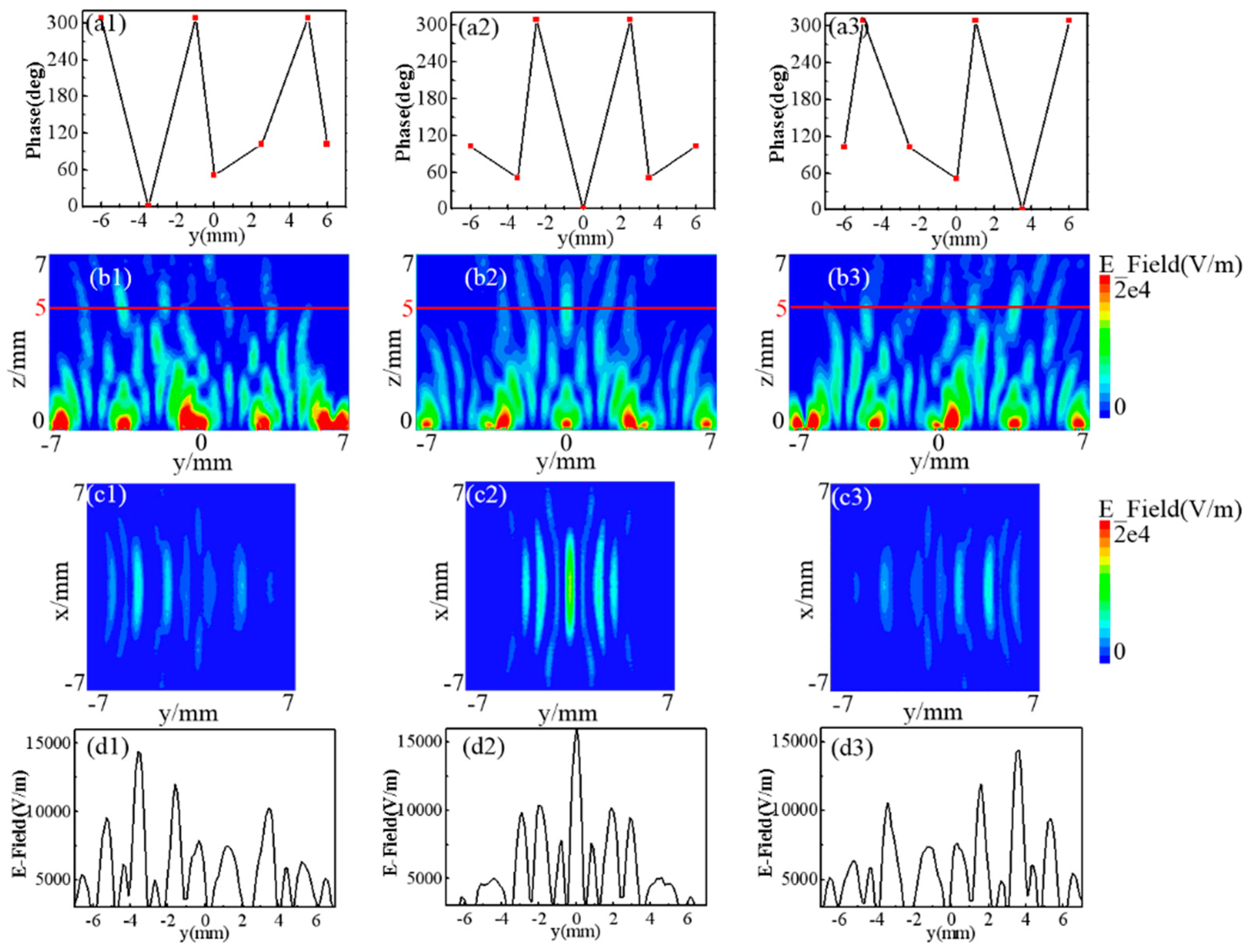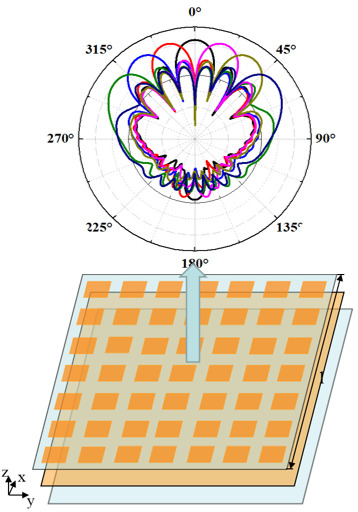Tunable Beam Steering, Focusing and Generating of Orbital Angular Momentum Vortex Beams Using High-Order Patch Array
Abstract
1. Introduction
2. Concept and Principles
3. Results and Discussion
3.1. Beam Steering
3.2. Beam Focusing
3.3. Generation of Multi-Order Orbital Angular Momentum Vortex Beams
3.4. Discussion
4. Conclusions
Author Contributions
Funding
Conflicts of Interest
References
- Suedan, G.A.; Jull, E.V. Beam Diffraction by Planar and Parabolic Reflectors. IEEE Trans. Antennas Propag. 1991, 39, 521–527. [Google Scholar] [CrossRef]
- Yurduseven, O.; Yurduseven, O. Compact parabolic reflector antenna design with cosecant-squared radiation pattern. In Proceedings of the 2011 IEEE Microwaves, Radar and Remote Sensing Symposium, Kiev, Ukraine, 25–27 August 2011; pp. 382–385. [Google Scholar]
- Cheng, Y.J.; Hong, W.; Wu, K. Millimeter-wave substrate integrated waveguide multibeam antenna based on the modified R-KR lens. In Proceedings of the 2008 IEEE MTT-S International Microwave Symposium Digest, Atlanta, GA, USA, 15–20 June 2008; pp. 703–706. [Google Scholar]
- Mehmood, A.; Karabey, O.H.; Ayluctarhan, M.; Zheng, Y.L.; Braun, H.; Hovhannisyan, M.; Letz, M.; Jakoby, R. Dielectric resonator antenna phased array with liquid crystal based phase shifters. In Proceedings of the 8th European Conference on Antennas and Propagation IEEE (EuCAP 2014), The Hague, The Netherlands, 6–11 April 2014; pp. 2436–2439. [Google Scholar]
- Mehmood, A.; Karabey, O.H.; Jakoby, R. Dielectric Resonator Antenna with Tilted Beam. IEEE Antennas Wirel. Propag. Lett. 2017, 16, 1119–1122. [Google Scholar] [CrossRef]
- Karabey, O.H.; Mehmood, A.; Ayluctarhan, M.; Braun, H.; Letz, M.; Jakoby, R. Liquid Crystal Based Phased Array Antenna with Improved Beam Scanning Capability. Electron. Lett. 2014, 50, 426–428. [Google Scholar] [CrossRef]
- Perez-Palomino, G.; Baine, P.; Dickie, R.; Bain, M.; Encinar, J.A.; Cahill, R.; Barba, M.; Toso, G. Design and Experimental Validation of Liquid Crystal-Based Reconfigurable Reflectarray Elements with Improved Bandwidth in F-Band. IEEE Trans. Antennas Propag. 2013, 61, 1704–1713. [Google Scholar] [CrossRef]
- Doumanis, E.; Dickie, R.; Baine, P.; Perez-Palomino, G.; Cahill, R.; Goussetis, G.; Encinar, J.A.; Barba, M.; Christie, S.; Mitchell, N. Nematic Liquid Crystals for Reconfigurable Millimeter Wavelength Antenna Technology. In Proceedings of the 2013 7th European Conference on Antennas and Propagation IEEE (EuCAP), Gothenburg, Sweden, 8–12 April 2013; pp. 1791–1792. [Google Scholar]
- Perez-Palomino, G.; Encinar, J.A.; Barba, M.; Carrasco, E. Design and Evaluation of Multi-Resonant Unit Cells Based on Liquid Crystals for Reconfigurable Reflectarrays. IET Microw. Antennas Propag. 2012, 6, 348–354. [Google Scholar] [CrossRef]
- Perez-Palomino, G.; Florencio, R.; Encinar, J.A.; Braba, M.; Dickie, R.; Cahill, R.; Baine, P.; Bain, M.; Boix, R.R. Accurate and Efficient Modeling to Calculate the Voltage Dependence of Liquid Crystal-Based Reflectarray Cells. IEEE Trans. Antennas Propag. 2014, 62, 2659–2668. [Google Scholar] [CrossRef]
- Perez-Palomino, G.; Barba, M.; Encinar, J.A.; Cahill, R.; Dickie, R.; Baine, P.; Bain, M. Design and Demonstration of an Electronically Scanned Reflectarray Antenna at 100 GHz Using Multiresonant Cells Based on Liquid Crystals. IEEE Trans. Antennas Propag. 2015, 63, 3722–3727. [Google Scholar] [CrossRef]
- Florencio, R.; Encinar, J.A.; Boix, R.R.; Perez-Palomino, G. Dual-Polarisation Reflectarray Made of Cells with Two Orthogonal Sets of Parallel Dipoles for Bandwidth and Cross-Polarisation Improvement. IET Microw. Antennas Propag. 2014, 8, 1389–1397. [Google Scholar] [CrossRef]
- Karabey, O.H.; Gaebler, A.; Strrunck, S.; Jakoby, R. A 2-D Electronically Steered Phased-Array Antenna with 2×2 Elements in LC Display Technology. IEEE Trans. Microw. Theory Tech. 2012, 60, 1297–1306. [Google Scholar] [CrossRef]
- Zhao, Y.Z.; Huang, C.; Qing, A.Y.; Luo, X.G. A Frequency and Pattern Reconfigurable Antenna Array Based on Liquid Crystal Technology. IEEE Photonics J. 2017, 9, 1–7. [Google Scholar] [CrossRef]
- Zhang, T.; Li, L.M.; Xia, H.Y.; Ma, X.J.; Cui, T.J. A Low-Cost and High-Gain 60-GHz Differential Phased Array Antenna in PCB Process. IEEE Trans. Compon. Packag. Manuf. Technol. 2018, 8, 1281–1291. [Google Scholar] [CrossRef]
- Ma, S.; Zhang, S.Q.; Ma, L.Q.; Meng, F.Y.; Erni, D.; Zhu, L.; Fu, J.H.; Wu, Q. Compact Planar Array Antenna with Electrically Beam Steering from Backfire to Endfire Based on Liquid Crystal. IET Microw. Antennas Propag. 2018, 12, 1140–1146. [Google Scholar] [CrossRef]
- Guo, Z.Y.; Xu, H.S.; Guo, K.; Shen, F.; Zhou, H.P.; Zhou, Q.F.; Gao, J.; Yin, Z.P. High-efficiency visible transmitting polarizations devices based on the GaN metasurface. Nanomaterials 2018, 8, 333. [Google Scholar] [CrossRef] [PubMed]
- Zhou, H.P.; Chen, L.; Shen, F.; Guo, K.; Guo, Z.Y. Broadband Achromatic Metalens in the Midinfrared Range. Phys. Rev. Appl. 2019, 11, 024066. [Google Scholar] [CrossRef]
- Wang, J.J.; Zhou, J.; Guo, K.; Shen, F.; Zhou, Q.F.; Yin, Z.P.; Guo, Z.Y. High-efficiency terahertz dual-function devices based on the dielectric metasurface. Superlattices Microstruct. 2018, 120, 759–765. [Google Scholar] [CrossRef]
- Guo, K.; Xu, H.S.; Peng, Z.Y.; Liu, X.; Guo, Z.Y. High-efficiency full-vector polarization analyzer based on GaN metasurface. IEEE Sens. J. 2019, 19, 3654–3659. [Google Scholar] [CrossRef]
- Bogosanovic, M.; Williamson, A.G. Microstrip Antenna Array with a Beam Focused in The Near-Field Zone for Application in Noncontact Microwave Industrial Inspection. IEEE Trans. Instrum. Meas. 2007, 56, 2186–2195. [Google Scholar] [CrossRef]
- Stephan, K.D.; Mead, J.; Pozar, D.M.; Wang, L.Y.; Pearce, J.A. A Near Field Focused Microstrip Array for a Radiometric Temperature Sensor. IEEE Trans. Antennas Propag. 2007, 55, 1199–1203. [Google Scholar] [CrossRef]
- Durney, C.H.; Iskander, M.F. Antennas for Medical Applications. In Antenna Handbook; Springer: Boston, MA, USA, 1988; pp. 596–654. [Google Scholar]
- Shen, F.; Mu, J.N.; Guo, K.; Wang, S.M.; Guo, Z.Y. Generation of continuously-variable-mode vortex electromagnetic waves with three-dimensional helical antenna. IEEE Antennas Wirel. Propag. Lett. 2019, 18, 1091–1095. [Google Scholar] [CrossRef]
- Wang, L.L.; Chen, H.Y.; Guo, K.; Shen, F.; Guo, Z.Y. An Inner-and Outer-Fed Dual-Arm Archimedean Spiral Antenna for Generating Multiple Orbital Angular Momentum Modes. Electronics 2019, 8, 251. [Google Scholar] [CrossRef]
- Deng, C.J.; Chen, W.H.; Zhang, Z.J.; Li, Y.; Feng, Z.H. Generation of OAM Radio Waves Using Circular Vivaldi Antenna Array. Int. J. Antennas Propag. 2013, 2013, 847859. [Google Scholar] [CrossRef]
- Li, H.; Kang, L.; Wei, F.; Cai, Y.M.; Yin, Y.Z. A Low-Profile Dual-Polarized Microstrip Antenna Array for Dual-Mode OAM Applications. IEEE Antennas Wirel. Propag. Lett. 2017, 16, 3022–3025. [Google Scholar] [CrossRef]
- Bai, X.D.; Liang, X.L.; Sun, Y.T.; Hu, P.C.; Yao, Y.; Wang, K.; Geng, J.P.; Jin, R.H. Experimental Array for Generating Dual Circularly-Polarized Dual-Mode OAM Radio Beams. Sci. Rep. 2017, 7, 40099. [Google Scholar] [CrossRef] [PubMed]
- Guo, Z.Y.; Wang, Z.K.; Dedo, M.I.; Guo, K. The Orbital Angular Momentum Encoding System with Radial Indices of Laguerre–Gaussian Beam. IEEE Photon. J. 2018, 10, 1–11. [Google Scholar] [CrossRef]
- Wang, Z.K.; Dedo, M.I.; Guo, K.; Zhou, K.Y.; Shen, F.; Sun, Y.X.; Liu, S.T.; Guo, Z.Y. Efficient recognition of the propagated orbital angular momentum modes in turbulences with the convolutional neural network. IEEE Photon. J. 2019, 11, 7903614. [Google Scholar] [CrossRef]
- Feng, Z.K.; Wang, X.Y.; Dedo, M.I.; Guo, K.; Shen, F.; Kai, C.H.; Guo, Z.Y. High-density Orbital Angular Momentum mode analyzer based on the mode converters combining with the modified Mach–Zehnder interferometer. Opt. Commun. 2019, 435, 441–448. [Google Scholar] [CrossRef]
- Kai, C.H.; Feng, Z.K.; Dedo, M.I.; Huang, P.; Guo, K.; Shen, F.; Gao, J.; Guo, Z.G. The performances of different OAM encoding systems. Opt. Commun. 2019, 430, 151–157. [Google Scholar] [CrossRef]
- Nikfalazar, M.; Kohler, C.; Wiens, A.; Mehmood, A.; Sohrabi, M.; Maune, H.; Binder, J.R.; Jakoby, R. Beam steering phased array antenna with fully printed phase shifters based on low-temperature sintered BST-composite thick films. IEEE Microw. Wirel. Compon. Lett. 2016, 26, 70–72. [Google Scholar] [CrossRef]
- Technology Solutions for THz Electronics, Schottky Zero-Bias Diode, 3DSF5. Available online: https://www.acst.de/downloads/ACST_Datasheet_3DSF5.pdf (accessed on 3 July 2019).
- Timsina, R.L.; Messner, R.A.; Kubwimana, J.L. A compact design of switched line phase shifter for a microstrip phased array antenna. In Proceedings of the 2017 Progress in Electromagnetics Research Symposium-Fall (PIERS-FALL), Singapore, 19–22 November 2017; pp. 1839–1844. [Google Scholar]
- Kunz, K.S.; Luebbers, R.J. The Finite Difference Time Domain Method for Electromagnetics, 1st ed.; CRC Press: Boca Raton, FL, USA, 1993; pp. 1–101. [Google Scholar]
- Yu, N.F.; Genevet, P.; Kats, M.A.; Aieta, F.; Tetienne, J.P.; Capasso, F.; Gaburro, Z. Light propagation with phase discontinuities: Generalized laws of reflection and refraction. Science 2011, 334, 333–337. [Google Scholar] [CrossRef]
- Li, R.Z.; Guo, Z.Y.; Wang, W.; Zhang, J.R.; Zhang, A.J.; Liu, J.L.; Qu, S.L.; Gao, J. High-efficiency cross polarization converters by plasmonic metasurface. Plasmonics 2015, 10, 1167–1172. [Google Scholar] [CrossRef]
- Zuo, H.J.; Choi, D.Y.; Gai, X.; Ma, P.; Xu, L.; Neshev, D.N.; Zhang, B.P.; Barry, L.D. High-Efficiency All-Dielectric Metalenses for Mid-Infrared Imaging. Adv. Opt. Mater. 2017, 5, 1700585. [Google Scholar] [CrossRef]
- Akram, M.R.; Bai, X.D.; Jin, R.H.; Vandenbosch, G.A.E.; Premaratne, M.; Zhu, W. Photon spin Hall effect based ultra-thin transmissive metasurface for efficient generation of OAM waves. IEEE Trans. Antennas Propag. 2019, 67, 4650–4658. [Google Scholar] [CrossRef]







| Parameter | lp | wp | p | w1 | l1 | l2 | l3 | l4 |
|---|---|---|---|---|---|---|---|---|
| Element 2 | 0.303 | 0.392 | 1 | 0.143 | 0.04 | 0.09 | 0.14 | 0.02 |
| Element 3 | 0.303 | 0.392 | 1 | 0.143 | 0.09 | 0.19 | 0.29 | 0.02 |
| Element 4 | 0.303 | 0.392 | 1 | 0.143 | 0.14 | 0.29 | 0.09 | 0.02 |
| Element 5 | 0.303 | 0.392 | 1 | 0.143 | 0.19 | 0.04 | 0.24 | 0.02 |
| Element 6 | 0.303 | 0.392 | 1 | 0.143 | 0.24 | 0.14 | 0.04 | 0.02 |
| Element 7 | 0.303 | 0.392 | 1 | 0.143 | 0.29 | 0.24 | 0.19 | 0.02 |
| Element | 1 | 2 | 3 | 4 | 5 | 6 | 7 | |
|---|---|---|---|---|---|---|---|---|
| Phase Order | ||||||||
| 0 | 0 | 0 | 0 | 0 | 0 | 0 | 0 | |
| 1 | 0 | 1 | 2 | 3 | 4 | 5 | 6 | |
| 2 | 0 | 2 | 4 | 6 | 1 | 3 | 5 | |
| 3 | 0 | 3 | 6 | 2 | 5 | 1 | 4 | |
© 2019 by the authors. Licensee MDPI, Basel, Switzerland. This article is an open access article distributed under the terms and conditions of the Creative Commons Attribution (CC BY) license (http://creativecommons.org/licenses/by/4.0/).
Share and Cite
Yin, Z.; Zheng, Q.; Guo, K.; Guo, Z. Tunable Beam Steering, Focusing and Generating of Orbital Angular Momentum Vortex Beams Using High-Order Patch Array. Appl. Sci. 2019, 9, 2949. https://doi.org/10.3390/app9152949
Yin Z, Zheng Q, Guo K, Guo Z. Tunable Beam Steering, Focusing and Generating of Orbital Angular Momentum Vortex Beams Using High-Order Patch Array. Applied Sciences. 2019; 9(15):2949. https://doi.org/10.3390/app9152949
Chicago/Turabian StyleYin, Zhiping, Qun Zheng, Kai Guo, and Zhongyi Guo. 2019. "Tunable Beam Steering, Focusing and Generating of Orbital Angular Momentum Vortex Beams Using High-Order Patch Array" Applied Sciences 9, no. 15: 2949. https://doi.org/10.3390/app9152949
APA StyleYin, Z., Zheng, Q., Guo, K., & Guo, Z. (2019). Tunable Beam Steering, Focusing and Generating of Orbital Angular Momentum Vortex Beams Using High-Order Patch Array. Applied Sciences, 9(15), 2949. https://doi.org/10.3390/app9152949







